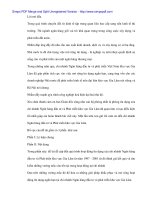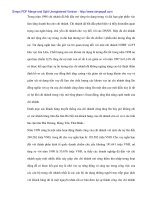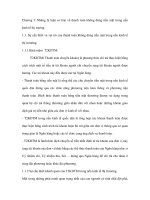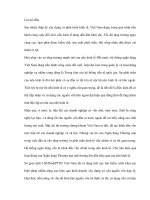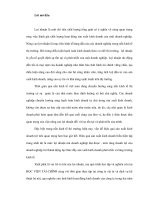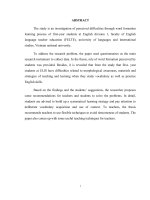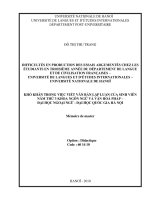Khó khăn trong việc học từ vựng của học sinh dân tộc thiểu số ở Trường PTDT nội trú Sơn La và một số giải pháp khắc phục
Bạn đang xem bản rút gọn của tài liệu. Xem và tải ngay bản đầy đủ của tài liệu tại đây (610.94 KB, 51 trang )
1
VIETNAM NATIONAL UNIVERSITY, HANOI
UNIVERSITY OF FOREIGN LANGUAGES AND INTERNATIONAL STUDIES
FACULTY OF POST-GRADUATE STUDIES
PHẠM THỊ THU HIỀN
INVESTIGATING DIFFICULTIES IN VOCABULARY
LEARNING OF ETHNIC MINORITY LEARNERS AT
SON LA ETHNIC BOARDING HIGH SCHOOL
AND SOME SUGGESTED SOLUSIONS
(Khó khăn trong việc học từ vựng của học sinh dân tộc thiểu số
ở trường PTDT nội trú Sơn La và 1 số giải pháp khắc phục)
M.A. MINOR THESIS
Field: English Teaching Methodology
Code: 601410
Hanoi - 2010
2
VIETNAM NATIONAL UNIVERSITY, HANOI
UNIVERSITY OF FOREIGN LANGUAGES AND INTERNATIONAL STUDIES
FACULTY OF POST-GRADUATE STUDIES
PHẠM THỊ THU HIỀN
INVESTIGATING DIFFICULTIES IN VOCABULARY
LEARNING OF ETHNIC MINORITY LEARNERS AT
SON LA ETHNIC BOARDING HIGH SCHOOL
AND SOME SUGGESTED SOLUSIONS
(Khó khăn trong việc học từ vựng của học sinh dân tộc thiểu số
ở trường PTDT nội trú Sơn La và 1 số giải pháp khắc phục)
M.A. MINOR THESIS
Field: English Teaching Methodology
Code: 601410
Supervisor: KIM VĂN TẤT, M.A
Hanoi - 2010
6
TABLE OF CONTENTS
DECLARATIONS i
ACKNOWLEDGEMENTS ii
ABSTRACT iii
PART A: INTRODUCTION 1
1. Rationale 9
2. Aims of the study 9
3. Scope of the Study 9
4 Methods of the Study 10
5. Design of the study 10
PART B: DEVELOPMENT 12
CHAPTER 1: LITERATURE REVIEW 12
1.1. General knowledge of English Vocabulary 12
1.1.1. What is vocabulary? 12
1.1.2. Classification of vocabulary 13
1.1.2.1. In term of the concept of morpheme 13
1.1.2.2. In term of the meaning 13
1.1.2.3. In term of the function of vocabulary items in a sentence 13
1.1.2.4. In term of the sequence of use 14
1.1.2.5.In term of the use of word 14
1.2. The role of vocabulary in language teaching and learning 14
1.3. Factors affecting vocabulary acquisition. 15
1.4. Methods in vocabulary teaching 15
1.4.1. The Grammar- Translation Method 16
1.4.2. The Direct Method 16
1.4.3. The Audio-lingual method 17
1.4.4. The Silent Way 17
1.4.5. Suggestopedia 18
1.4.6. Total Physical Response (TPR) 18
1.4.7. The Communicative Approach (Communicative Language Teaching – CLT) 19
7
1.5. Teaching and learning vocabulary through communicative activities 20
1.5.1. Characteristics of communicative activities 20
1.5.2. Characteristics of vocabulary communicative activities 20
1.5.3. Vocabulary teaching techniques in combination with communicative activities
21
1.5.3.1. Visual techniques 21
1.5.3.2. Verbal techniques 22
1.5.3.3. Using Games 22
1.5.3.4. Role play 23
CHATER 2: METHODOLOGY 24
2.1. Research questions 24
2.2. Subject of the study 24
2.2.1. the students’ background and learning condition 24
2.2.2. The students’ Vietnamese language competence 25
2.3. The instruments 25
2.3.1. The questionnaire 25
2.3.2. The interview 26
CHAPTER 3: DATA ANALYSIS AND DISCUSSION 27
3.1. Results and discussions from the questionnaires 27
3.2. Results and discussion from the interview 31
CHAPTER 4: FINDING AND SOME SOLUTIONS FOR BETTER LEARNING
ENGLISH VOCABULARY TO ETHNIC MINORITY STUDENTS IN SON LA
ETHNIC BOARDING HIGH SCHOOL. 32
4.1. Students’ difficulties (through interview) 32
4.1.1. Lack of general knowledge 32
4.1.2. Lack of Motivation 32
4.1.3. Deficiency of Vietnamese 32
4.1.4 Lack of Time 33
4.1.5. Lack of an appropriate syllabus for ethnic minority students 33
4.1.6. Lack of communicative environment 34
4.2. Difficulties caused by the English differences between the written and spoken
form 34
8
4.3. Difficulties caused by other factors 34
4.3.1. Grammar-based examinations 34
4.3.2. Large class 34
4.4. Suggested Solutions 35
4.4.1. Using pictures 35
4.4.2. Using word guessing game 40
4.4.3. Using Semantic Mapping 41
4.4.4. Using Realia. 43
4.4.5. Guessing word in context 44
4.4.6. Organizing English speaking clubs 46
4.4.7. Guiding students’ home revision 46
4.5. Better current situations 46
4.5.1. Providing teachers with more professional support 46
4.5.2. Improving the students’ Vietnamese competence 46
4.5.3. Raising the students’ general knowledge 47
4.5.4. Educating ethnic minority teachers to teach English for students in their
communities 47
4.5.5. Improving learning, teaching conditions at school. 47
PART C: CONCLUSION 48
1. Conclusions 48
2. Limitations of the study 48
3. Suggestion for further study 49
REFERENCES 50
APPENDIXS
9
PART A: INTRODUCTION
1. Rationale
Viet Nam is a country with 54 ethnic groups namely: Kinh, Tay, Thai, Muong, Dao,
H‘mong, Khmu, Khme, etc. In the past, all of these ethnic groups took part in protecting
and saving the nation together and now they are contributing their time and efforts to the
nation construction. However, in some parts of the country where these ethnic minorities‘
living , the standard of the living is still below the normal level. In order to help them
improve their living conditions a lot of things in education and economy are needed.
Son la is a small, remote and mountainous province with many ethnic groups so
Son la Ethnic Boarding High School is established to cater for the education of their
children. At this school, each ethnic group has its own language, but they have to use
Vietnamese in teaching and learning. That is why when they learn English, it is really their
second foreign language. Surely, you can imagine the difficulties the pupils have with this
language.
In addition, I find out that my pupils are not successful learners, only because they
lack vocabulary. In fact they are provided with almost every word necessary for their
communication inside and outside the classroom, but many of my pupils complain that
they that forget most of learned words only a few day later. This proves that problems in
learning vocabulary are undeniable. For better vocabulary teaching and learning, I have
chosen Investigating difficulties in vocabulary learning of ethnic minority learners at
Son La Ethnic Boarding high school and some suggested solutions as the subject matter
of the study.
2. Aims of the study
- To identify the typical difficulties in learning vocabulary for ethnic minority
students at Son La Ethnic Boarding high school.
- To suggested some solutions to overcome the difficulties.
3. Scope of the Study
The study only concentrates on problems and possible solutions in learning
vocabulary from the textbook ― Tiếng Anh 10‖ by Hoang Van Van, Hoang Thi Xuan Hoa,
Do Tuan Minh, Nguyen Thu Phuong and Nguyen Quoc Tuan.
10
4 Methods of the Study
The study uses a combination of various methods to achieve its objectives such as
descriptive, comparative, and statistical. Various sources of data, including those obtained
from the students in the Son La Ethnic Boarding High school.
First, survey questionnaires were conducted. Data obtained help to investigate
students‘ difficulties learning English vocabulary at Son la Ethnic boarding High School
and also help teachers to find out appropriate activities to improve vocabulary learning.
Secondly, the author interviewed 10 ethnic students to get better understanding of
their difficulties in learning vocabulary.
5. Design of the study
The thesis consists of three parts as follow:
Part A: Introduction
Part B: Development
Part B is composed of three chapters, each of which focused on a particular issue:
- Chapter I deal with Theoretical Background.
- Chapter II describes the method employed and introduces the situation of teaching
and learning vocabulary at Son La Ethnic Boarding High School.
- Chapter III describes the data analysis and discussion about the students‘
difficulties in learning vocabulary at Son La Ethnic Boarding High School.
- Chapter IV is the Finding and some solutions for better learning English
vocabulary to Ethnic minority students in Son La Ethnic Boarding High school.
Part C: Conclusion
11
12
PART B: DEVELOPMENT
CHAPTER 1: LITERATURE REVIEW
1.1. General knowledge of English Vocabulary
1.1.1. What is vocabulary?
Up to now there have been many definitions of vocabulary. Some linguists define it
according to semantic criterion while others refer to it according to the phonological or
potential one.
According to Parmer (1983:37),the semantic unit maybe a sequence of several
words. For example, ―look up‖ is a phrasal verb consisting of two words. But the meaning
of ―look up‖ can only be understood in the entire phrase, not by analyzing its single parts.
Word is also defined with phonological criterion. It is said that word is marked by
―spaces‖ and ―pauses‖.
According to Michael Lewis (1993:89), vocabulary ―…may be individual words, or
full sentences – institutionalized utterances – that convey fixed social or pragmatic
meaning within a given community.‖
Ur, P. (1996: 60) defines vocabulary as the words we teach in the language. The
author also emphasizes that a new item of vocabulary may be more than a single word; for
example, post office and mother-in-law, which are made up of two or three words but
express a single idea. There are also multi-word idioms such as call it in day, where the
meaning of the phrase can not be deduced from an analysis of component words. There
fore, a useful convention is to cover all cases by talking about vocabulary ―items‖ rather
than ― word‖.
Meanwhile in spite of the fact that many scientists talked about linguistics, the
notion of word, they did not give any definition of word on their own. According to Quirk
(1974), ―Thinking of word comes to us so naturally that it takes a serious effort to realize
what miraculous devices they are. Like so many other things that are basic and elemental
in our lives, we take them for granted and we apt to be surprised to find how hard it is to
say exactly what a word is‖.
Pyles and Alges (1970: 96) also state, ―When most of us think about language we
think first about words. It is true that the vocabulary is the focus of language. It is words
that sounds and meanings interlock to allow us to communicate with one an other, and it is
13
word that we arrange together to make sentences, conversation and discourse of all kinds‖.
It indicates that vocabulary is essential for learning a language.
In short, it is possible to say that it is hard to give a precise definition of word. For
the pedagogical purposes of this paper, the definition by Ur, P. (1996) is used.
1.1.2. Classification of vocabulary
There have been different ways to classify vocabulary according to different criteria.
1.1.2.1. In term of the concept of morpheme
Vocabulary is divided into three kinds: simple words, deriver words and compound
words.
- Simple words: A simple word consists of a root morpheme, such as big, hat…
- Derived words: A derived words consists of a root and one or more derivational
morphemes like player, interesting…
- Compound words: A compound word has at least two roots with or without
derivational morphemes. For example: plant-eater, racing horse…
1.1.2.2. In term of the meaning
There are two main kinds of meaning in a word: lexical meaning and grammatical
meaning. There fore, vocabulary can be divided in to notional words and functional words.
Notional words are words with clear lexical meaning. They address objects, actions,
qualities, etc. And they have meaning in themselves. Notional words form a great number
of each speaker‘s vocabulary.
Functional words are words whose meaning is grammatical and only have meaning
in relation to the other words with which they are used. Functional words are particles,
articles, prepositions…
1.1.2.3. In term of the function of vocabulary items in a sentence
According to the function of vocabulary items in a sentence, vocabulary can be
divided into parts of speech: nouns, verbs, adjectives, adverbs, prepositions and pronouns.
Each part of speech has its own position complying with certain grammatical rules and
relating to others.
The teacher should point out the function of each item so that students can use its
grammatical rules correctly.
14
1.1.2.4. In term of the sequence of use
The sequence of use means the frequency of occurrence of words. There are three
groups of word according to this criterion. They are high frequency words, low frequency
words and specialized words.
It is very important for the teacher to show students which group a word be long to,
because it is unnecessary to spend so much time learning low frequency words.
1.1.2.5. In term of the use of word
According to this criterion we have active words and passive words. Active words
are those which students are able to use after they have learned them. Passive words are the
ones students do not have to use. They are used especially in the texts to create necessary
understanding and use them correctly and naturally.
1.2. The role of vocabulary in language teaching and learning
―Vocabulary is one of the three dimensions of a language (phonetics, grammar,
vocabulary). Without grammar, very little can be conveyed, without vocabulary nothing
can be conveyed”. (Wilkin, 1972:110)
The statement indicates the great importance of vocabulary. Since vocabulary is so
important, teaching and learning vocabulary should be paid enough attention to. The main
objective of language learners is to understand and be understood in their communication
using the language acquired. In order to achieve this aim, they have to study a certain
number of vocabulary items. If some one has adequate vocabulary, he or she will feel more
confident when communicating with others as well as expressing his/ her opinions in both
oral and written forms. Regarding this matter, Wallace (1982) said: “Failure to find the
words one needs to express himself is the most frustrating experience in speaking another
language”.
It is clear that mastering the meanings and especially the use of a word has an
important role in learning a foreign language in general and in learning English in
particular. If someone misuses words, people will misunderstand him. If one can use
correct grammar but does not have exact words to express one‘s opinion, it is quite hard to
build up a successful conversation. The more words one knows well, the more successful
he is in communication and the more information he can get from different sources such as
books, newspapers, etc. In other words, a good knowledge of vocabulary will help learners
develop the four skills: speaking, listening, reading, and writing. Therefore teaching and
15
learning vocabulary are significant in learning a foreign language, especially in the light of
the communication approach.
1.3. Factors affecting vocabulary acquisition.
There have been different opinions or factors that affect vocabulary acquisition.
However, they all share some main points. Below are four types of factor said to have great
impact on language learners‘ vocabulary acquisition.
The first type is the person- dependent factors including age, sex, language, and
cognitive and learning style. These factors differ from person to person. They are relative
stable, and they determine to a large extent how a learner approaches a task.
The second is the learning task which includes the materials being learnt (such as
the genre of a piece of reading) as well as the goal the learner is trying to achieve by using
these materials (such as remembering, comprehending or using language). Different types
of task materials, task purposes, and tasks at various difficulty level demand different
strategies.
The third type of factor is the learning context. It is the socio-cultural-political
environment where learning takes place. The learning context can include the teachers, the
peer, the classroom climate, the family support, the social, cultural tradition of learning, the
curriculum, and the availability of input and out put opportunities. These factors have a
certain effect on the ways learners approach learning task and acquire vocabulary
knowledge.
Last but not least, we cannot forget to mention strategy. A learning strategy is a
series of actions a learner takes to complete a learning task. A strategy starts when the
learner analyzes the task, the situation, and what is available in his/her repertoire. The
learner then goes on to select, deploy, monitor, and evaluate the effectiveness of this action,
and decides if he/she needs to revise the plan and action.
In short, the factors discussed above (person, task, context, and strategy) exist
together and make a configuration of a particular learning situation that will help to bring
about the effectiveness of vocabulary.
1.4. Methods in vocabulary teaching
Markey (1978:138) states, “The method used has been said to be the cause of
success or failure in language learning, for it is ultimately the method that determines
what and the how of language instruction”. This statement shows us the importance of
16
methodology. It is methodology that determines success or failure in language teaching.
That is the reason why teacher have to understand well about different methods so that
they can choose the best ones for their learners. Below is a brief discussion on some
methods in vocabulary teaching in history and their role in vocabulary teaching and
learning.
1.4.1. The Grammar- Translation Method
The Grammar- Translation Method is the application of methods which was widely
used in the formal teaching of Latin and Greek and was adopted as the chief means for
teaching foreign languages in many European educational institutions. Hubbard (1983:328)
states that the grammar translation method ― is the traditional deductive method of
language teaching, based on classical studies of dead language which consists of giving
rules, paragons and vocabulary and getting students to apply this new knowledge to
translation‖. In term of vocabulary teaching, students are given lists of vocabulary with
isolated words. They are taught grammatical rules and paradigms to put words together.
Translating from mother tongue into target language and vice-versa is emphasized while
little or no attention is paid to pronunciation. At the same time, it is assume that language
consists of written words that exist in isolation, as though they were individual bricks that
could be translated one by one into their foreign equivalents and then assessed according to
grammatical rules into sentences in the foreign language. For this reason, learners may
think that language is just a collection of words which are isolated and independent and
there must be a corresponding word in the mother tongue for each foreign word they learn.
Moreover, this method may reduce students‘ motivation as long lists of vocabulary may
make them bored and undisciplined. As a result, they will not have adequate vocabulary.
However, this method is easy to apply and also easy to test and control. It used to be
widely used in high schools in Vietnam. To some extent teachers and students could gain
some benefit from it when the goal of learning was passing tests and exams, but now this
goal has been changed and the method proves not to be suitable any more.
1.4.2. The Direct Method
The Direct Method appeared as the result of a revolution in language teaching
philosophy. It is described in details by Diane Larsen- Freeman in her book techniques and
Principles in Language Teaching (1986). According to this method, new teaching points
are taught through modeling and practice. This means that people learn to speak a language
17
by speaking it and associating utterances directly with actions. The second language
learning is treated as the first language learning. In the classroom, only the target language
is used. For vocabulary, words used are very common, active and concerning every day
activities. Concrete vocabulary is taught through demonstration, objects, and pictures while
abstract vocabulary is taught by association of ideas. At the same time, correct
pronunciation is greatly emphasized. Language learners, there fore, can use vocabulary
they have learnt effectively in communication. However this method is not easy for us to
apply as its needs small class sizes, enough teaching aid, talented teachers, budget and time.
This is why the Direct Method has not been used widely in Vietnam.
1.4.3. The Audio-lingual method
The Audio-lingual Method appeared in World War 2. At that time, the ―Army
Method‖ was developed to build communicative competence in translators through very
intensive language courses focusing on aural/oral skills. This is combination with some
new ideas about language learning coming from the disciplines of descriptive linguistics
and behavioral psychological went on to become what is known as the Audio-lingual
method. According to Brown (1994) and Prator and Celce- Murcia (1979), the overall goal
of the Audio-lingua Method was to create communicative competence in learners. Thus, in
this method, vocabulary is strictly limited and learned in context and there is much
dependence on mimicry, memorization of set phrases, and over learning. Furthermore,
great importance is attached to pronunciation. To carry out vocabulary teaching that way,
some common techniques are exploited such as repetition drill, single slot substitution drill
use of minimal pairs, etc.
With such kinds of practice, students will have better memory of words, terms and
phrases and know how to use them practically. This way of teaching also make the class
more active and motivated in learning. However, because of the lack of teaching and
learning facilities this method has not been commonly use in high schools in Vietnam.
1.4.4. The Silent Way
The Silent Way has founded by Caleb Gattegno as a method for language learning
for early 70s. The most prominent characteristics of the method was that the teacher
typically stayed ―silent‖ most of the time, as part of his/her role as facilitator and stimulator.
That is the reason why the method‘s popular name is ―The Silent Way‖.
18
As Larsen- Freeman (1986) described, in this method, Cuisinere rods (small rods of
varying color and length) are typically used to introduce vocabulary and syntax, along with
colorful wall charts. There is also the sound-color chart, 12 words charts each containing
around 500 words, and 8 Fidel charts for the English language.
In addition, word charts with the sounds in each word corresponding in color to the
sound-color chart are used by students to build sentences. Last but not least is the Fidel
chart – a chart that is color- coded according to the sound- color chart but includes the
various English spellings so that they can be directly related to actual sounds
1.4.5. Suggestopedia
In the late 70s, a Bulgarian psychologist began to develop a language learning
method that focused on ― de-suggestion‖ of the limitations learners think they have, and
providing the soft of relaxed state of mind that would facilitate the retention of material to
its maximum potential. This method became known as ―Suggestopedia‖.
According to this method, vocabulary is learnt from posters and decorations around the
learning environment. It can also be presented and given treatment from the teacher, but
not dwelt on. The particular thing is that it is acquired in a special learning environment
with soft cushioned seating, dim light and Baroque music. Music, drama, and the ―arts‖ are
integrated into the learning process as often as possible.
Suggestopedia provides some valuable insights into the power of cognition and
creating or employing techniques that make students feel comfortable and relaxed, and
―suggestible‖ to the material being learnt. However, it is impossible to apply this way to
high school students as we lack equipment and teaching condition. Soft cushioned seating
and dim lighting are not available for us. We can only use it in combination with other
methods to make the lesson more interesting.
1.4.6. Total Physical Response (TPR)
In the 1960s, James Asher began experimenting with a method he called Total
Physical Response. The method involves a substantial amount of listening and
comprehension in combination with various ―physical response‖ (smiling, reaching,
grabbing, looking, etc) well before learners begin to use the language orally. It is also
focused on the ideas that learning should be fun and stress-free as possible, and that it
should be dynamic through the use of accompanying physical activity. According to this
19
method, vocabulary is emphasized over other language areas by using commands to direct
behavior, role reversal or action sequence.
For school students, if this method is used in combination with other methods, it
can interest them. However, it is not quite suitable for heterogeneous classes to take part in
activities that require total physical activities.
1.4.7. The Communicative Approach (Communicative Language Teaching – CLT)
Hubbarb( 1983:236) states: “ Communicative approach to language teaching takes
as its starting points the use of communicative purpose of language. The approach,
therefore strongly advocates careful attention to the use rather than merely form and
meaning. It would also favor functional organization of teaching materials. It might tend to
support a “deep-end” approach to presentation of new language, in which students are
first to cope with the communication task as fast as possible before being given the new
necessary form‖.
According to this method, vocabulary is learnt through ―real life‖ communication
in the class room, through interaction in the target language and through an enhancement
of the learners‘ own experiences as important contributing elements to classroom learning
and through an attempt to link classroom language learning activation outside the
classroom. This approach indicates that knowing a word does not mean knowing the
meaning of the word only. New words must be taught in combination with pronunciation,
spelling, grammar and collocation in order to help the students catch proper and effective
use of them. These are the most crucial principles that teachers should bear in mind when
teaching vocabulary:
New words must be taught in context;
A few words are presented at a time and creating favorable conditions for the
students to practice and use them as much as possible;
Encouraging students to guess new words, especially when reading;
Words should be practiced in context rather than memorizing them isolate;
Not all words are of the same importance, so teachers should not try to treat all
of them as active vocabulary.
20
In comparison with other method, this method has more advantages, so it has been used in
many high schools. However, choosing appropriate techniques to teach vocabulary is one
problem. Thus, in spite of applying the CLT many teachers have not been successful.
1.5. Teaching and learning vocabulary through communicative activities
1.5.1. Characteristics of communicative activities
Today it seem that the goal of teaching and learning language is the students‘
ability to communicate, so communicative activities are put in great emphasis on. This is
also true in vocabulary teaching and learning.
Yanping, P (2005:3) remarks ―Communicative activities refer to activities which are
organized in classes with elements of communicative functions, and students‟
improvisation‖.
In every communicative activity students are asked to take part in communication
with others. According to Wood, L. (1981) communicative activities have four
characteristics as follows:
- providing “whole- task” practice;
- improving motivation;
- allowing natural learning;
- creating a context that supports learning.
When being involved in communicative activities students feel more motivated as
they need to communicate with one an other to find out unknown information. Besides,
many aspects of language learning can take place through natural processes, which operate
when a learner is involved in using the language for communication. Communication
activities in class are used to get learners to use the language they are learning to interact in
a realistic and meaningful way. Thus, they are an important part of the learning process.
Finally, they provide opportunities to promote relationships among learners and
between learner and the teacher. This relationship can help to humanize the classroom and
create a environment that supports the students in their effort to learn.
1.5.2. Characteristics of vocabulary communicative activities
According to Nation, P. and Newton, J. (2000:224), communicative activities that
encourage vocabulary learning have following features:
- Helping speakers to set their speech to a suitable level for particulars listeners
and to adjust it when listeners indicate a lack of understanding;
21
- Providing a meaningful context or an illustrated setting within which to
encounter new vocabulary;
- Learners being exposed to repeated use of the new items during the course of the
activity;
- Learners being likely to be required to use new items productively in the activity.
These features include the choice of vocabulary and its placement within the textual input
for the activities, the teacher‘s and learners‘ strategies for arriving at the meaning of these
features and the way they affect learners‘ responses to unfamiliar vocabulary, teachers can
improve the quality of vocabulary learning that is likely to occur during performance of
communicative activities.
Another point to remember is that communicative activities encouraging vocabulary
learning are not limited to oral productive language. A communicative activity can be a
written format such as vocabulary exercises including word-building, matching words with
various types of definitions, studying vocabulary in context, semantic mapping, and split
information activities focusing on vocabulary. Thus, choosing a relevant communicative
activity for teaching requires teachers‘ though and planning.
1.5.3. Vocabulary teaching techniques in combination with communicative
activities
When you think of vocabulary, there is a good change that you think of long lists of
words from textbooks, spelling word lists, or even the humongous lists of terms to study
for exams. Perhaps the least effective way to study vocabulary is the ―look and remember‖
techniques. Here, students typically stare at the term and definition, apparently trying to
activate photographic memory they wish they had.
According to vocabulary techniques, communicative activities can be classified as
follows:
1.5.3.1. Visual techniques
According to Zebrowska (cited in Gaim and Redman (1986)), visual techniques
pertain visual memory. Learners remember better the material that has been presented by
means of visual aids. So, communicative activities using visual aids such as flashcards,
photographs, blackboard drawings, wall charts and relia (i.e. object themselves) can
stimulate students to speak the language. Regarding visual aids, students can benefit from
communicative activities since they ―help to provide the situation which light up the
22
meaning of the utterances used‖ (Lee, W.R. and Coppen, H,1970:1). Besides, mine and
gesture are often used to supplement other ways of conveying meaning. Teachers can make
use of the blackboard and gesture to reinforce the concept. For example, make the typical
gesture with your hand as you say ―Stand up‖, ―Come here‖, or ―Sit down‖; mine writing
as you say ―Write the answers‖, or mine distributing things as you say, ― Please give out
these photocopies‖.
1.5.3.2. Verbal techniques
Vocabulary teaching and learning communicative activities can be carried out by
mean of verbal techniques as follows:
i) Use of illustrative situation (oral and written): To ensure that students
understand, teachers often make use of more than one situation context to check that
learners have grasped the concept.
ii) Use of synonyms and definitions: Teachers often use synonymy where they
have to compromise and restrict the length and complexity of their explanations. Besides,
definition alone is often inadequate as a mean of conveying meaning , and clearly
contextualized examples are generally required to clarify the limits of the item.
iii) Contrasts and opposites: This technique often asks ―What is the opposite
of…?‖
iv) Examples of the type: To illustrate the meaning of super ordinates such as
‗furniture‘, ‗vegetable‘, ‗meat‘ and ‗transport‘, it is common procedure to exemplify them,
ex. Table, chair, bed and sofa are all furniture. Some of these can of course also be dealt
with through visual aids.
1.5.3.3. Using Games
Up to now games have proved to be very effective in vocabulary teaching and
learning as they can encourage, entertain, teach and promote fluency. Haycraft (1987: 50)
suggest that there are large varieties of word games that are especially useful for practicing
and revising vocabulary after it has been introduced . Numerous puzzles, word squares,
crosswords, jigsaw task, picture- describing, are useful for pair or group work. More
clearly, games provide a situation in which they provide a setting in which
communication is essential and therefore they will become a stimulating and interesting
way to help students acquire the target language without even realizing it.
23
1.5.3.4. Role play
Role-play activities can involve a written text or oral production. However oral
activities are more effective since they help to create the presence of a real-life situation in
the classroom. Ladouse, G.P (1987:5) stresses, “When students assumes a „role‟, they play
a part either their own or some body else‟s in a specific situation. „Play‟ means that the
role is taken on in a safe environment in which students are as inventive and playful as
possible. In the roles, students are experimenting with their knowledge of the real world
and developing their ability to interact with other people”.
Furthermore, activities of this kind let students develop and practice vocabulary in
combination with other language skills such as grammar and speaking, and create the
motivation and involvement necessary for learning to occur. Teachers can prepare a lot of
situation such as Going Shopping, Preparing a Party. What students have to do is work in
pairs improvising a suitable dialogue for each situation, so they will have less pressure and
will be more willing to participate in the role-play.
24
CHATER 2: METHODOLOGY
2.1. Research questions
1. What kinds of difficulties do ethnic minority learners in Son La Ethnic Boarding
high school often meet when learning vocabulary?
2. What are the most effective ways to teach vocabulary to these learners?
2.2. Subject of the study
2.2.1. The students’ background and learning condition
The study was conducted at the Son La Ethnic Boarding High School, which is one
of the high schools in Son La that teach ethnic minorities students.
The researcher chose 40 ethnic minority students in Son La ethnic boarding high
school for the subjects of this study. They are both male and female students at the age of
fifteen. All of them are minor ethnic people (the Thai). They have been learning English
since they were in 6
th
form. However, the knowledge of their English vocabulary is still
very poor.
Most of the students in this study come from every part of the province and belong
to ethnic minority groups. They come from farmer families in the remote villages. They
study and live in Son La ethnic Boarding High School, they are far away from home, so
some of them suffer from being homesick because this is the first time they have to live far
from their family. This certainly affects their study.
In addition, at the weekend they come back home and have to spend most of their
time helping their parents do farming and house works, so they do not have time to do their
homework. Also, their parents are too busy to help them with their lessons. On the other
hand they think that, schooling is their children‘s responsibility and teacher‘s job, so they
pay little attention to their children‘s schooling or do not encourage them to learn harder.
Moreover, the school‘s equipment is very poor, and out of date. All the classrooms
are simply brick built, the furniture was old and not very comfortable. The school is
located at the main street so it is very noisy. Sometimes the street‘s activities distracted
students‘ attention from their lesson. The class size is large (40 – 45) so the teachers can
not control the classes effectively. Besides, all the teaching facilities the teachers have are
the text books, chalk, and old board so that the teachers‘ lectures are often boring. More
than that, there are not many English books, English stories, pictures, CDs or cassette tapes
in school library. There are not any clubs or organizations for students to improve or
25
nourish their language skills. Computers and internet are rarely used by teachers and far
from imagination of the ethnic students. In general, the learning condition for the students
observed was very poor and not suitable for students to learn any subjects.
Most of the English teachers in Son La Ethnic Boarding High School are from
other provinces, and most of them are Kinh people. In their teaching, they meet many
difficulties and experience numerous culture shocks because in these classes, most of
students are minor ethnic groups. Moreover, the teaching materials are not available for all
of the students.
2.2.2. The students’ Vietnamese language competence
They are pure ethnic students, and Thai is their first language, they always use it
everyday to communicate with their parents and other members of their communities.
They only use Vietnamese at schools or at public places, so their Vietnamese competence
is still limited. When they learn English they have to learn two foreign languages at the
same time. You are sure to imagine all sorts of difficulties those ethnic students have to
overcome.
2.3. The instruments
The study aims to find out ethnic students‘ difficulties in learning English
vocabulary. In order to have a deep understanding in this issue, the researcher distributes
questionnaires to students. Secondly, she interviews 10 of the students.
2.3.1. The questionnaire
At the beginning of March 2010, the author did a survey on this topic to develop an
appropriate survey instrument for this study. The final questionnaire was administered to
40 ethnic students. In order to make sure that, all the students fully understand the
questions, the questionnaires were written in Vietnamese. All of the distributed
questionnaires were returned with answers.
The purpose of the questionnaire was to examine how important the ethnic minority
students think of their learning English and what difficulties they often meet when learning
vocabulary. On this basic, the researcher will propose some relevant suggestions to help
learners to over come these difficulties.
26
2.3.2. The interview
A one – to – one interview was conducted after the administration of student
questionnaire in class. It was carried out in Vietnamese, in the form of informal
conversation between the researcher and the students. While formulating the interview
questions, the interviewer made sure that the questions were clear, precise and motivating.
10 ethnic students were randomly selected for the interview. The questions in the
interviews were basically based on those in the questionnaire to get more understanding
about the difficulties in learning English vocabulary of the ethnic minority students. Each
conversation lasted for 5 – 7 minutes, in order that the interviewees have enough time to
answer all questions.
27
CHAPTER 3: DATA ANALYSIS AND DISCUSSION
Data analysis is not a simple description of the data collected but a process by
which the researcher can bring interpretation to the data (Powney & Watts,1987). In the
following parts, the researcher interprets the results from the feedback of the
questionnaires, interviews and observations. The study mentions the ethnic students‘
constraints in learning English vocabulary.
3.1. Results and discussions from the questionnaires
The following questions from questionnaire will be considered to obtain data for
analysis and discussion:
1. What nationality are you?
One hundred percents of the ethnic minority students are Thai people.
2. How do you think of your Vietnamese language competence?
One hundred percents of the students admitted that their Vietnamese is very poor.
They can only understand very simple Vietnamese. Their vocabulary is rather small. They
can not express complicated things in Vietnamese.
3. Do you think that English is important for your job in the future?
They know clearly that, English is very important for their job in the future, all of
them chose the answer ―yes‖. But they still do not spend enough time on learning English,
because of many factors that hinder them from doing so. Firstly, they do not have time to
learn, secondly, some of them think they can learn it later when they have opportunity.
4. How long have you learned English?
To this question, the students have the same answers, they have studied English for
four years (since they were in 6
th
form).
5. What do you think of learning English vocabulary?
Items
Number of students
Percentage (%)
a. Very difficult and boring
25
62.5%
b. Difficult
13
32.5%
c. Interesting and easy
2
5%
Table 1
28
It can be seen from question 4 that approximately 62.5% of the students considered
vocabulary learning difficult and boring. 32.5% of students feel vocabulary learning
difficult and the lowest percentage of the students considered it interesting and easy. It
resulted from the fact that students entered this school with low level of knowledge and
low motivation. Their previous knowledge of English is very poor and now they almost
stared from the beginning. Most of them were not interested in learning English as it took
much more time and energy than other subjects. Some students think that learning
vocabulary is simply to memorize the words‘ spelling and its Vietnamese equivalents.
When being asked about the reason why they feel bored in learning vocabulary, the
learners said that they just copied new words provided by their teachers or marked and
underlined words they did not know in their text books then noted the meaning in
Vietnamese.
6. How much time do you usually spend learning vocabulary outside classroom?
Time spent
Percentage (%)
a. About one hour a day
15
b. More than two hours a day
10
c. About two hours a day
15
d. No time at all
60
Table 2
Although the students highly appriciate the role of learning vocabulary, only a
small number of them spend enough time learning it. Just 30% in total spend from one to
two hours daily learning; only 10% spend more than two hours and over half students 60%
spend no time at all in learning new words. This can be explained that English is not
students‘ majors there fore they do not spend much time on learning vocabulary. In school,
students have to learn many subjects and they do not pay much attention to learning
English. They only concentrate on some subjects, which they believe to be useful for their
future, such as, math, literature, physics, chemistry or biology.
